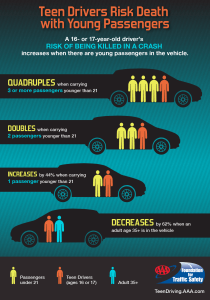PREVENTING TEEN CAR ACCIDENTS
Motor vehicle crashes are the leading cause of death for U.S. teens, according to the Centers for Disease Control. (CDC) Fatal car accidents are a tragedy whether the victims are young or old. But the statistics don’t lie and if a fatal auto accident can be prevented, the lawyers at Joseph Joy and Associates in Lafayette feel strongly that it is incumbent upon all of us, especially parents, to heed the warnings and exercise discipline over young drivers. When it comes to newly licensed teens, their risk of becoming involved in a car accident is particularly high during the first months they obtain their license or permit. The fatal crash rate per mile driven is nearly twice as high for 16-17 year olds compared with 18-19 year olds, according to the CDC.

Source: LA Highway Safety Comm.
The graphic from the Louisiana Highway Safety Commission (LHSC), right, illustrates the risk a teenage driver faces when he or she gets in the car with young passengers. According to LHSC, a 16 or 17 year old driver’s risk of being involved in a fatal car accident increases dramatically when there are young passengers in the vehicle. It quadruples when the young driver is carrying three or more passengers younger than 21. It doubles when there are two passengers younger than 21 in the car and increases by 44% when a 16 or 17 year old driver is carrying a passenger younger than 21 in the vehicle. “These statistics are stunning and should give every parent pause when their child asks for the keys to the car to visit a friend or transport their friends,” said Lafayette Automobile Accident Attorney Joseph Joy, managing partner of Joseph Joy and Associates.
The Louisiana Highway Safety Commission (LHSC) considers a motorist a “young driver” if they are between the ages of 15 to 24. It may sound odd to group an adult over 21 years of age with a fledgling driver but the statistics bear it out. According to LHSC, during 2017 in Louisiana, there were 88 fatal crashes involving drivers aged 15 – 20 years old and 108 fatal crashes involving drivers aged 21 – 24 years old.
- 9,824 injury crashes involving drivers 15 – 20 years old
- 9,310 injury crashes involving drivers 21 – 24 years old
“Inexperience, coupled with immaturity, often results in risk-taking behaviors such as speeding, alcohol use, and not wearing a seat belt—all of which contribute to increased fatal and injury crashes,” is the position of the LHSC.
GRADUATED DRIVERS LICENSING (GDL)
To keep teen drivers safer on the roads, all states have enacted Graduated Drivers Licensing laws that phase in driving privileges. LHSC insists that research has shown significant reductions in fatal accidents when graduated drivers licensing laws include age requirements, a waiting period of at least three months before the intermediate stage, a restriction on nighttime driving, 30 or more hours of supervised driving and a restriction on carrying passengers or the number and age of passengers carried. A study conducted by the AAA Foundation for Traffic Safety found that 6 out of 10 teen crashes involve some form of driver distraction – including interaction with one or more passengers, using a cell phone, singing/dancing to music, and grooming.
“As with everything else involving a child, especially teenagers, parents set the tone and are a major influence on young drivers and their respect of driving laws. It is not enough for parents to delegate this responsibility to driver’s ed instructors. Parents should set an example for their children by practicing safe driving habits, always buckling up, never texting and respecting speed limits at all times,” said Attorney Joseph Joy.
Under Louisiana’s graduated driver’s license laws, drivers are eligible for a learner’s license at 15 years of age. However, in order to qualify they are required to have successfully completed a driver’s education course her RS 32:402.1, passed a visual exam and a written test with the Office of Motor Vehicles or Driving School. There are restrictions once they are granted a learner’s license. The young driver must be accompanied by license parent, Guardian, or adult at least 21 years of age or older, or a licensed sibling at least age 18 or older. The young driver must also complete at least 50 hours of supervised driving, 15 of those hours at night. There can be no cell phone usage including hands-free.
A 16 year old teenager is eligible for an intermediate license so long as they have possessed a learner’s license for a minimum of 180 days, completed 50 hours of supervised driving, 15 of those hours at night, has had no at-fault crashes with their learner’s license, no moving violations with their learner’s license, no curfew drug or alcohol law violations and successful completion of a road skills test with the Office of Motor Vehicles or Driving School. An intermediate license has the following restrictions:
Driving is restricted between 11 p.m. to 5 a.m. unless the 16 year old driver is accompanied by a licensed parent, guardian or adult at least 21 years of age or a license sibling 18 years or older. The 16 year old driver may not transport more than one passenger under 21 years of age between 6 p.m. and 5 a.m. unless the passenger is a member of their immediate family. Again, the young driver is prohibited from using cell phones for talk, text unless for emergencies. And of course, all drivers must follow mandatory seat belt laws.
Once 17 years old, a teenager can apply for a Class E Louisiana driver’s license which holds no restrictions. The applicant must complete the required requirements for an intermediate license, have no at-fault crashes for 12 consecutive months, no moving violations for 12 consecutive months and no curfew, drug or alcohol law violations for 12 consecutive months.
The full laws are below. Be sure and read them closely if you are a parent or guardian of a teenager about to apply for driving privileges. Call the personal injury attorneys at the Lafayette law firm of Joseph Joy and Associates should your teenage or young adult driver suffer an injury due to the negligence of another driver.
Universal Citation: LA Rev Stat § 32:407
- 407. Application of minors; revocation; applications of persons less than twenty-one years of age
A.(1) The application of any minor applying for operating privileges shall not be granted, unless it is signed by either the father or mother of the applicant, who has legal custody of the applicant, otherwise, by the tutor or other person having custody of him. However, only the domiciliary parent may sign if joint custody has been awarded. A license issued to a minor shall be issued upon compliance with the other provisions of this Chapter.
(2)(a) Upon completion of a driver’s education course approved by the Department of Public Safety and Corrections, public safety services, and upon passing a visual examination and a road knowledge test, including rules of the road, signs, and signals, sharing the road with motorcycles and tractor/trailer trucks, and not less than two questions relative to railroad and highway grade railroad safety, an applicant at least fifteen years of age, but less than seventeen years of age, applying for the first time may be issued a Class “E” learner’s license. The license may be issued for a four-year period at the same fee as a Class “E” driver’s license and must be maintained for at least one hundred eighty days, unless prior to such time the driver reaches seventeen years of age, prior to being converted to a Class “E” intermediate driver’s license. The Class “E” learner’s license shall authorize the holder to drive while being accompanied by a licensed parent, guardian, adult at least age twenty-one or older, or licensed sibling at least age eighteen or older.
(b) Any applicant at least sixteen years of age, but less than seventeen years of age, moving into Louisiana from another state shall be eligible for the issuance of a Class “E” intermediate driver’s license provided such applicant meets all other requirements for licensure in Louisiana and furnishes the department with proof of successful completion of an equivalent driver’s education course and proof of issuance of a learner’s license for a minimum of one hundred eighty days, unless prior to such time the driver reaches seventeen years of age, from the state of previous residence.
(3) The Class “E” learner’s license may be converted to a Class “E” intermediate license upon the applicant being at least sixteen years of age and meeting the following conditions:
(a) The applicant’s parent or legal guardian shall provide a signed statement to the department attesting that the applicant has completed a minimum of fifty hours of supervised driving practice with a licensed parent, guardian, or adult at least age twenty-one or older. At least fifteen of these hours must be nighttime driving.
(b) The applicant shall pass an on-road driving skills test. An applicant may satisfy this requirement by one of the following means:
(i) The applicant passes the test administered by an employee of the department.
(ii) The applicant provides a certificate to the department from an agent or properly licensed and contracted third-party tester as provided in this Chapter.
(c) The applicant shall have held the Class “E” learner’s license for at least one hundred eighty days if he is not seventeen years of age while remaining accident free, except where the licensee was not at fault, and receiving no convictions for moving violations or violations of the seat belt or curfew laws of this state or any law pertaining to drug or alcohol use.
(4) The intermediate license shall restrict those under the age of seventeen from driving between 11:00 p.m. and 5:00 a.m. unless otherwise accompanied by a licensed parent or guardian, a licensed adult at least twenty-one years of age, or a licensed sibling at least eighteen years of age. In addition to a licensed parent, sibling, or guardian, there may be other members of the licensee’s immediate family in the vehicle. Unless accompanied by a licensed parent, guardian, or adult at least age twenty-one or older, an intermediate licensee may not between the hours of 6:00 p.m. and 5:00 a.m. transport more than one passenger that is under twenty-one years of age and not a member of the intermediate licensee’s immediate family. When the intermediate licensee is accompanied by a driver’s education instructor, there may be one or more fellow driver’s education students in the vehicle. The intermediate licensee shall not place the vehicle in motion until every occupant of the vehicle has been restrained by a properly fastened seat belt or other occupant restraint system unless such person is not required to be restrained pursuant to R.S. 32:295.1.
(5) Upon completing the Class “E” intermediate licensing stage, and upon demonstrating that the licensee has remained accident free, except in cases where the licensee was not at fault, has received no convictions for moving violations, and has received no convictions for violations of the seat belt or curfew laws of this state or any laws pertaining to drug or alcohol use for twelve consecutive months after being issued his intermediate license, an applicant may be issued full Class “E” driving privileges.
(6) The department may establish rules and regulations to extend the term of the intermediate license if an applicant’s license has been suspended, the applicant has been placed on probation by a court due to a driving violation, or the applicant has violated any of the provisions of Paragraph (5) of this Subsection. The term of the extension of the intermediate license shall be for no less than thirty days nor more than one hundred eighty days from the end of any suspension or probation period, or from the date he would otherwise have been eligible to apply for a Class “E” permanent license in the case of a violation of Paragraph (5) of this Subsection. The applicant shall attend and successfully complete either an approved driver education course or prelicensing training course established under contract or license with the Department of Public Safety and Corrections, public safety services, regardless of any prior completion of such course, as a condition of reinstatement of the license suspended pursuant to this Paragraph. The licensee shall have the right to an administrative hearing to appeal the determination of the department to extend the applicant’s intermediate license. The provisions of this Paragraph shall apply to any licensee who has not attained the age of eighteen.
- Notwithstanding any provision of law to the contrary, the department may deny the application or revoke the license of a minor upon the forwarding of a written request to the department by the parent, tutor, or other person having legal custody who has not signed the application for a license.
- The department may promulgate rules and regulations for the enforcement and administration of this Section.
- Beginning January 1, 2000, and thereafter, licenses issued pursuant to this Section to applicants less than twenty-one years of age shall contain a highly visible distinctive color to clearly indicate that the license has been issued to an applicant less than twenty-one years of age. The Department of Public Safety and Corrections, office of motor vehicles, shall promulgate rules and regulations no later than December 1, 1999, in accordance with the Administrative Procedure Act to implement the provisions of this Section, including but not limited to the choice of color and placement on the license.
- Repealed by Acts 2010, No. 1039, §2, eff. Jan. 1, 2011.
- Any person under eighteen years of age shall be subject to the requirements of R.S. 32:431.1.
Give us a call: 337-232-8123 or visit us at 900 S. College Rd., Ste. 204, Lafayette, LA.




